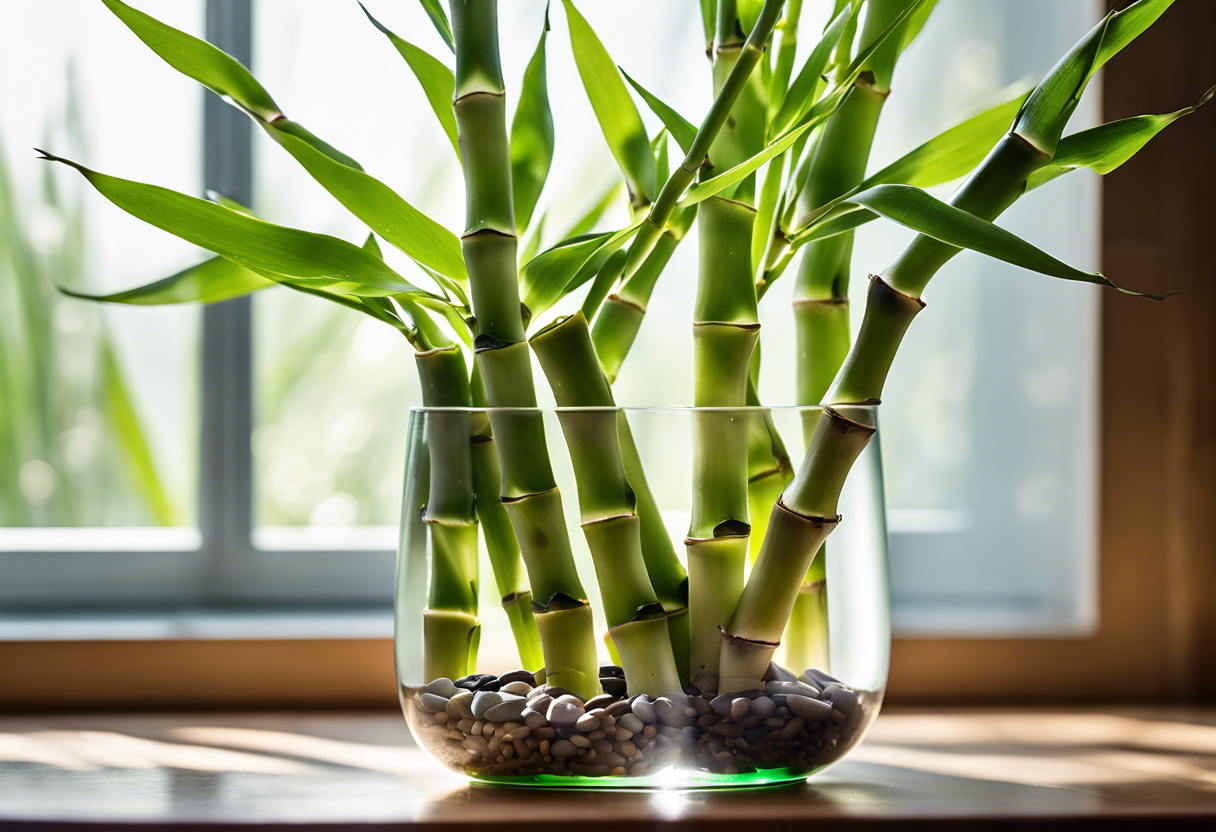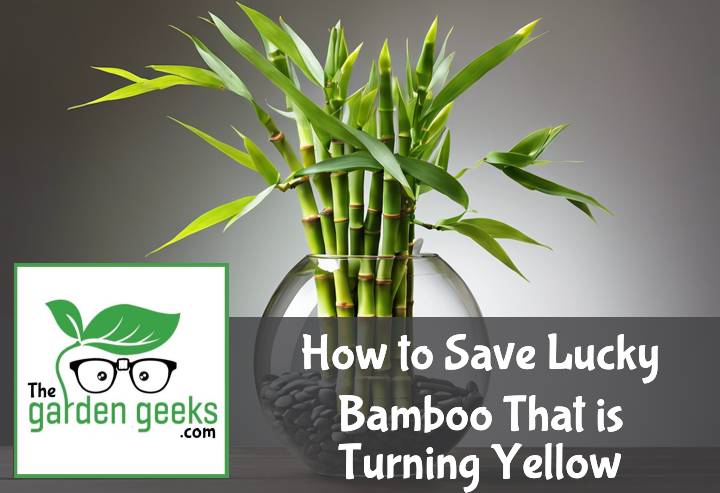Ever found yourself staring at your once vibrant green lucky bamboo, now a sad shade of yellow, and wondering what you did wrong? Well, you’re not alone. I’ve been there too! Learning how to Save Lucky Bamboo That is Turning Yellow can feel like a daunting task.
But don’t worry! This guide will help you understand why your beloved plant is looking a bit under the weather and more importantly, how to nurse it back to health. So buckle up, plant enthusiasts; we’re about to become lucky bamboo saviors! Keep reading about How to Save Lucky Bamboo That is Turning Yellow.
Key Takeaways
- Yellowing in lucky bamboo can be due to overwatering, lack of light, or poor water quality.
- To save the plant, first identify the cause. If it’s overwatered, let it dry out before watering again.
- If it’s due to poor light, move it to a brighter location but avoid direct sunlight.
- For poor water quality, use filtered or distilled water instead of tap water.
- Cut off any yellow parts to prevent further damage and propagate them if possible.

Why is My Lucky Bamboo Turning Yellow?
When it comes to lucky bamboo care, yellowing is a common issue that can leave plant enthusiasts scratching their heads. It’s like your green thumb has suddenly turned yellow! But don’t fret, this discoloration isn’t a death sentence for your beloved bamboo. It’s just a sign of some bamboo health issues that need addressing.
Understanding the Causes of Yellowing
So, what causes this unsightly yellowing? Well, it could be due to several factors. One major culprit is overwatering. Yes, you heard right! Your love and attention might be drowning your plant. Overwatering can lead to root rot which in turn results in yellowing bamboo.
Another factor could be insufficient light exposure. Just like us humans, plants need their daily dose of sunshine too! If your lucky bamboo isn’t getting enough light, it might start turning yellow as an SOS signal.
Temperature stress on plants is another cause for concern. If your indoor temperature fluctuates wildly or if the plant is exposed to extreme temperatures, it can cause the leaves to turn yellow.
Nutrient deficiencies are also a common cause of plant discoloration. If your bamboo isn’t getting enough nutrients from its soil or water source, it may show signs of distress by turning yellow.
Lastly, improper soil pH can also lead to yellowing in lucky bamboos. These plants prefer slightly acidic soil and if the pH levels are off, they might start showing signs of unhappiness through color changes.
Common Mistakes Leading to Yellowing
Now that we’ve understood the causes let’s look at some common mistakes that often lead to these problems. Over-fertilization is one such mistake. While fertilizers are great for providing nutrients, too much of anything can be harmful and this holds true for plants as well!
Incorrect watering practices are another common mistake made by plant owners. Remember, your lucky bamboo isn’t a fish! It doesn’t need to be submerged in water all the time.
Poor lighting conditions can also lead to yellowing. If your bamboo is stuck in a dark corner of your house, it might start feeling a bit blue…or rather, yellow!
Wrong temperature settings can also stress out your plant. Lucky bamboos prefer stable temperatures and sudden changes can cause them distress.
Lastly, unsuitable soil selection can also lead to problems. Lucky bamboos aren’t too picky about their soil but they do prefer slightly acidic soil. So, if you’ve planted yours in alkaline soil, it might not be feeling too lucky after all!
Remember, the key to save lucky bamboo that is turning yellow is understanding what’s causing the problem and then taking corrective action. So keep an eye on these common mistakes and ensure you’re providing the right care for your lucky bamboo!
How Does Lucky Bamboo Normally Grow?

Lucky bamboo, despite its name, isn’t actually bamboo. It’s a type of Dracaena, and it’s a pretty chill plant. It doesn’t ask for much – just the right conditions and a bit of care.
Ideal Conditions for Lucky Bamboo
Now let’s talk about what makes this green guy happy. First up is light. Lucky bamboo light requirements aren’t too demanding. Indirect sunlight is best as direct sun can scorch its leaves.
Temperature-wise, lucky bamboo prefers things on the warmer side. The best temperature for lucky bamboo is around 65-95°F (18-35°C). Too cold or too hot and your plant might start throwing a tantrum.
When it comes to watering, these plants are like Goldilocks – not too much, not too little, but just right. Watering lucky bamboo once a week should do the trick.
And finally, soil. Or rather lack thereof! You see, soil for lucky bamboo isn’t really necessary. These plants are perfectly happy growing in water alone!
Signs of Healthy Growth in Lucky Bamboo
So how do you know if your efforts to save lucky bamboo that is turning yellow are working? Well, there are some telltale signs to look out for.
Firstly, check out those leaves! Healthy lucky bamboo leaves should be bright green and perky looking. If they’re drooping or turning yellowish-brown, something’s up.
Another sign to watch out for is overwatering. Yes folks, even water-loving plants like these can have too much of a good thing! If your plant starts getting mushy at the base or develops brown tips on its leaves – you might be dealing with signs of overwatering in lucky bamboos.
Lastly, keep an eye on the growth rate. A normal growth rate of a lucky bamboo is about an inch per month. If your plant’s shooting up like a rocket or not growing at all, it might be time to reassess its care.

How to Identify the Severity of the Problem?
When your Lucky Bamboo is turning yellow, it’s crucial to diagnose the severity of the problem. You’ll need to understand the visual cues and changes in plant health that indicate distress. Let’s dive into how you can identify early and advanced stages of Lucky Bamboo yellowing.
Early Signs of Distress in Lucky Bamboo
The initial symptoms in Lucky Bamboo are subtle, but they’re there if you know what to look for. The first signs of unhealthy bamboo might be a slight change in color. Instead of a vibrant green, your bamboo may start looking a bit dull or faded.
This could be an early sign of distress, indicating that your bamboo is starting to yellow. It’s like your plant’s way of sending out an SOS signal, saying “Hey, I’m not feeling so hot over here!” So keep an eye out for these signs and act quickly if you notice them.
Advanced Stages of Yellowing in Lucky Bamboo
Now let’s talk about what happens when things get serious. When the yellowing progresses in a Lucky Bamboo plant, it’s no longer just about aesthetics – it affects overall plant health too.
In severe cases, late-stage bamboo distress can lead to leaf drop or even stem rot. This is when we’re talking about severe lucky bamboo problems. The effects of prolonged yellowing are not pretty, folks! So remember, catch those early signs before they turn into advanced issues and save your Lucky Bamboo that is turning yellow!
What Steps Can I Take to Save My Yellowing Lucky Bamboo?
The moment you spot your lucky bamboo turning yellow, it’s time for some TLC. Saving yellowing lucky bamboo isn’t rocket science, but it does require immediate action and a long-term care plan. So let’s dive into the steps to save your lucky bamboo.
Immediate Actions to Halt Further Damage
First things first, don’t panic! Your plant is not doomed yet. Immediate actions for yellowing bamboo can help halt further damage. Start by checking the water quality. Too much chlorine or fluoride can cause yellowing. If that’s the case, switch to filtered or distilled water pronto!
Next up, inspect the roots. If they’re squishy and brown instead of firm and white, root rot might be the culprit. In such a scenario, trim off the rotten parts without delay.
Lastly, consider moving your plant to a new location if it’s getting too much direct sunlight or extreme temperature fluctuations. Remember, urgent care for lucky bamboo is all about quick response and correct methods.
Long-term Care Strategies for Recovery
Now onto the recovery phase! The key here is consistency in care – think of it as nursing your plant back to health.
Start with regular watering but avoid overdoing it – soggy soil is a big no-no for these guys! Next up: light exposure. Lucky bamboos love bright indirect light so find them a cozy spot near a window but away from direct sunlight.
Temperature control also plays a crucial role in recovering yellowing lucky bamboo. Keep them in an environment with stable temperatures between 65-95°F (18-35°C). And remember folks, patience is key when trying to save lucky bamboo that is turning yellow! It might take some time before you see improvements but hang in there – your green thumb efforts will pay off!
How Can I Prevent Future Yellowing in My Lucky Bamboo?
To prevent yellowing lucky bamboo and ensure future bamboo care, you need to maintain healthy plants and avoid potential threats. It’s like a bamboo boot camp, but with less sweating and more watering!
Best Practices for Maintaining Healthy Lucky Bamboo
First things first, let’s talk about healthy lucky bamboo care. You gotta treat your plant like a VIP – Very Important Plant! Watering is key here. Don’t drown it, but don’t leave it parched either. Find that Goldilocks zone of just right.
Next up, we have light exposure. Your bamboo isn’t a sunbathing beauty; too much sunlight can make it go all crispy. Instead, find a spot with indirect light where your plant can chill out.
Keeping the green in your bamboo is all about balance. Too much or too little of anything can turn your green thumb into a yellow one.
Potential Threats and How to Avoid Them
Now let’s tackle those pesky threats that could harm your lucky charm. Common lucky bamboo threats include diseases and pests (the insect kind, not your annoying neighbor).
Avoiding these issues is crucial for maintaining healthy plants. Keep an eye out for any changes in your plant’s appearance or behavior – yes, plants have behaviors too! If something seems off, it might be time for some plant TLC.
Preventing pest infestations in bamboos is another biggie. Nobody wants creepy crawlies on their plants! Regularly check for signs of pests and nip any problems in the bud before they become major issues.
Remember folks, prevention is better than cure when you’re trying to save lucky bamboo that is turning yellow!

To Wrap Up
Just like a toddler with a new toy, your lucky bamboo needs your attention to thrive. The key to Save Lucky Bamboo That is Turning Yellow is understanding its language – yellow leaves are its cry for help!
So, don’t let your green thumb turn yellow! Use these tips and bring back the vibrant green color we all love in our lucky bamboo. Remember, every plant deserves a second chance!


